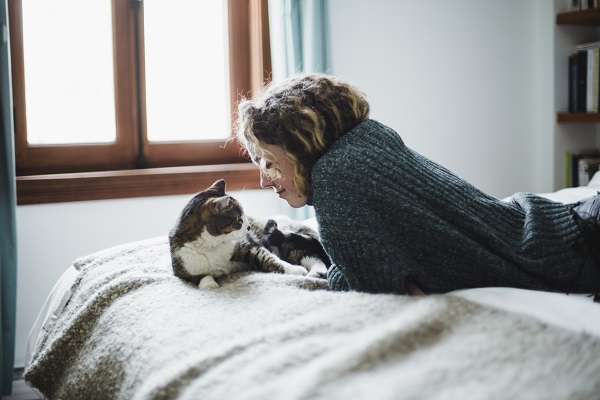-
Pets add value to our lives, improving our health, encouraging social interactions, and reducing stress, but what about their effect on kids? We delve into the research on the benefits of pet ownership to children and how to safely introduce a furry, feathery, or scaly member to your family.
Why add a pet to your family?
Growing up with a pet can provide numerous emotional, behavioural and social benefits. It can be a great way to teach children nurturing skills, responsibility, empathy for others and compassionate views towards animals. Studies have suggested that children raised with pets may have greater prosocial behaviour and more positive attitudes about their family life.
While more research is needed, there is also some evidence to suggest that children who are exposed to pets in infancy may be less likely to experience childhood asthma and respiratory tract illnesses, as well less likely to have allergies or sensitivities to animals later in life. And for the whole family, pets have been linked to a number of health benefits, including reducing stress and lowering blood pressure.
MORE: Can pets improve your mental health?
Which pet is best?
Provided you have the means to care for it—including adequate space and time – just about any pet can be a positive addition to your family. As mentioned above, dogs and cats offer scientifically-backed benefits, but smaller pets such as rabbits, guinea pigs, mice, rats, birds or fish are also great options. Just keep in mind that in addition to feeding, these smaller pets require regular cleaning of their cages or tanks, which is a great responsibility for older kids but might not be ideal for younger children.
If choosing a puppy or kitten, it’s a good idea to go through a breeder who’s socialised the litter with children. Going through a reputable breeder also means you’ll be able to get information about the pet’s personality, and that of its parents, before bringing it home. Rescue organisations are also great as you can ask for a pet who’s been kept in a foster home with children.
MORE: Choosing the right pet for you
Introducing a new pet to the family
Children will learn how to interact with your new pet from what you say as well as the behaviour you model. If you have a dog, show your kids how you hold your hand out, palm down, before patting it and how to be gentle and calm around a new cat. It’s also important to teach young children that animals feel pain, and how to identify a pet that wants to be left alone. Signs in dogs include lifted lips, growling, backing away, raised hackles, and staring, and flattening of ears and an arched back in cats.
It’s important to never leave your young ones unattended with dogs. According to the Royal Children’s Hospital Melbourne, 33% of dog bites to children are caused by the family dog or a dog known to the family, so correct supervision and teaching your child how to behave are essential.
MORE: Bringing your new pet home
Introducing a baby to your existing pet
Just as you prepare your home for your new addition, prepare your dog or cat in the months leading up to the birth of your baby. Teach them which rooms will be off limits well in advance, and introduce child-like contact such as gently pulling of the ears, tail or paws. You can also play recordings of babies crying to get them used to these new sounds.
Once your baby arrives, help your pets build positive associations with your new addition by rewarding them when near the baby, and going on walks together if you have a dog. Scolding your pet or locking it outside will only make it associate your baby with negative experiences.
Protecting your pet
Make sure your pet is microchipped, de-sexed, and registered with your local council. Regular vaccinations and vet check-ups are essential to keep your pet healthy and could save you money in the long run. If you have a dog or cat, it’s also a good idea to take out pet insurance to help towards vet bills if your pet’s involved in an accident or gets sick. Medibank has a range of Pet Insurance options for younger and older pets, with discounts for Medibank health members.
Pets and kids: What you need to know


Looking for Pet Insurance?
They bring out your best. Help protect them with Medibank Pet Insurance.
Three updated cover levels now available!ꭥ Plus, health members save 10% on premiums.# T&Cs apply.
Things you should know
Medibank Pet Insurance policies entered into for the first time prior to 30 August 2023 and subsequent renewals of those policies are issued by The Hollard Insurance Company Pty Ltd ABN 78 090 584 473, AFSL 241436, arranged and administered by PetSure (Australia) Pty Ltd ABN 95 075 949 923, AFSL 420183 (PetSure) and promoted and distributed by PetSure’s Authorised Representative (AR) Medibank Private Limited ABN 47 080 890 259, AR 286089 (Medibank).
Medibank Pet Insurance policies entered into for the first time on or after 30 August 2023, and subsequent renewals of those policies are issued by PetSure and promoted and distributed by PetSure’s AR, Medibank.
Any advice provided is general only and does not take into account your individual objectives, financial situation or needs. Please consider the Product Disclosure Statement (PDS) ensure this product meets your needs before purchasing, or choosing to continue with the product. PDS and Target Market Determination available at medibank.com.au/pet-insurance.
-
How is ‘phubbing’ hurting your relationships?
Here’s how to stop phubbing and be more mindful of your phone habits, to help improve face to face interactions with your family and friends.
-
Are the winter blues real?
Simple ways to boost your mood in winter.
-
Mental fitness explained
Just as you work to strengthen your body, your mental health deserves attention and exercise too.
-
Signs it's time to visit the dentist
Nobody wants to go. But there are good reasons to – promise.
-
The link between stress, anxiety and jaw pain
Physiotherapist Michael Chan explains how stress and anxiety can cause jaw pain, and how to help get some relief.
-
When you can't sleep next to your partner
You love everything about them – except their sleep habits.





.jpg)
